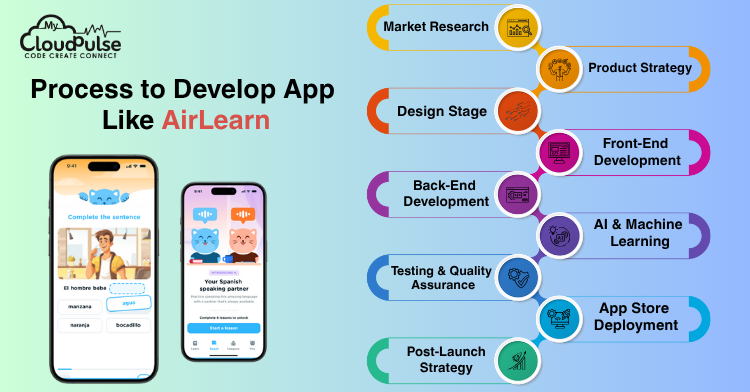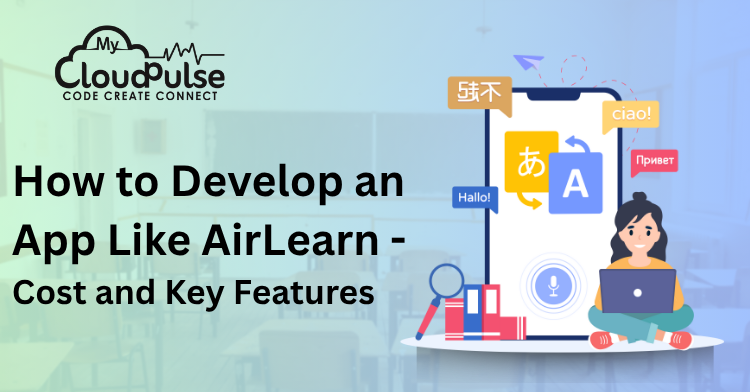In today’s hyperconnected world, breaking language barriers has become more than just a personal goal—it’s a professional and global necessity. Whether you’re a student, traveler, businessperson, or culture enthusiast, the ability to communicate in multiple languages opens doors to endless opportunities. Language learning apps have revolutionized the way people acquire new languages, offering flexibility, personalization, and accessibility.
Among the sea of language apps, AirLearn has carved a niche by focusing on authentic learning, cultural immersion, and a distraction-free interface. Unlike gamified platforms that often rely on repetition and scoring systems, AirLearn emphasizes meaningful progress and real-world context. If you’re aspiring to build a language learning app that genuinely helps users communicate across cultures, this guide will give you the blueprint to develop app like AirLearn from scratch.
We’ll explore the technical and creative dimensions of app development, from market research and design to technology stacks, monetization strategies, and team composition. Let’s dive in!
App Stats
Understanding AirLearn’s performance metrics and market positioning gives a solid foundation to replicate its success. Here’s a detailed look at the app’s current statistics:
- Platforms: AirLearn Android (via Google Play) and AirLearn iOS (via App Store)
- Developer: Unacademy Inc, a reputed name in the edtech space
- Languages Offered: 12 major global languages including Spanish, French, German, Hindi, Korean, and more
- Google Play Store:
- Rating: 4.6★ from 15,000+ reviews
- Installs: Over 500,000
- App Size: ~350 MB
- Category: Education
- Updated: Weekly
- Rating: 4.6★ from 15,000+ reviews
- Apple App Store:
- Rating: 4.8★ from 13.6K+ ratings
- Ranking: #11 in Education
- App Version: 3.13.23 (as of June 2025)
- Released: April 2024
- Rating: 4.8★ from 13.6K+ ratings
These statistics show that AirLearn enjoys strong user satisfaction and regular engagement. The app’s consistent updates indicate an active development and content pipeline, which is crucial for maintaining user interest in a learning app.
Essential Features to Develop App Like AirLearn
To build an app like AirLearn, you must focus on a wide range of features that appeal to different types of learners. Let’s expand each core feature:
1. Multi-language Support
Supporting multiple languages isn’t just about translation—it requires tailoring lessons to the nuances of each language, including grammar, cultural context, and writing systems. AirLearn offers 12 languages with diverse scripts and pronunciation needs, from alphabet-based English to character-based Chinese.
2. Modular Lesson Plans
Lessons are broken into grammar rules, vocabulary, dialogues, and cultural trivia. Each unit is modular, allowing learners to skip, revisit, or repeat modules as needed. Modular learning increases retention and gives users control over their pace.
3. Spaced Repetition System (SRS)
Instead of cramming, AirLearn uses spaced repetition to reinforce vocabulary and grammar. The algorithm adapts to the learner’s memory cycle, ensuring maximum retention with minimal stress.
4. Speaking & Pronunciation Practice
Voice recognition tools help learners improve speaking skills. AI evaluates intonation, speed, and accuracy. It’s especially helpful for tonal languages like Mandarin or complex sounds in French.
5. Cultural Context
AirLearn integrates cultural content within lessons. Learners explore slang, idioms, gestures, traditions, and food culture, enhancing their practical understanding of the language.
6. Minimalist Interface
The app avoids flashy animations and complex navigation. A clean, intuitive interface ensures learners stay focused on lessons. This is crucial for adult learners and professionals who prefer a serious, no-frills learning environment.
7. Gamified Elements
Unlike over-gamified apps, AirLearn uses gamification in moderation. XP points, daily streaks, and weekly leagues provide motivation without overshadowing the educational content.
8. Daily Goals & Streaks
Learners can set daily targets, track streaks, and earn badges. This feature encourages habit formation and consistent engagement—key ingredients in language mastery.
9. Community Learning
Peer-to-peer learning is encouraged through discussion boards, shared progress updates, and social milestones. It transforms learning from a solitary to a collaborative experience.
10. Progress Visualization
Users have access to dashboards that track completed modules, areas of strength and weakness, and overall language fluency estimates.
11. Offline Learning
For users with limited data or unstable internet, the app allows lesson downloads. This boosts accessibility in developing markets and supports on-the-go learning.
Monetization Models
A sustainable app needs revenue. AirLearn follows a hybrid monetization model that balances free content with value-added premium features:
1. Freemium Access
Basic lessons, limited quizzes, and one language are free. Advanced features like voice training, cultural lessons, or additional languages are locked behind a paywall.
2. Subscription Tiers
Monthly, quarterly, and annual plans offer:
- Unlimited access
- Offline mode
- Premium badges and leagues
- Speaking and writing practice
This tiered model ensures accessibility while generating recurring revenue.
3. In-App Purchases (IAP)
Users can buy XP boosters, special courses (e.g., business Spanish or travel-focused French), and bonus materials without subscribing.
4. Non-Intrusive Ads
Ads are minimal and do not interrupt lessons. Ad-free learning is available in premium plans.
5. Certification Revenue
Charge users for downloadable certificates after completing a course. These can be useful for resumes or academic applications.
Process to Develop App Like AirLearn
Creating a language app like AirLearn requires structured execution. Here’s a comprehensive breakdown of each stage:

1. Market Research
- Identify the most demanded languages globally
- Analyze user pain points in current apps (e.g., Duolingo, Babbel)
- Understand different learner personas (travelers, students, migrants)
2. Product Strategy
- Decide which languages to launch with
- Define core features for MVP
- Set KPIs: retention rate, daily active users, course completion
3. Design Stage
- Build user flowcharts and wireframes
- Create high-fidelity UI mockups
- Conduct usability testing to validate experience
4. Front-End Development
Tech stack options:
- Cross-platform: Flutter, React Native
- Native: Swift (iOS), Kotlin (Android)
Integrate:
- Lesson display modules
- Audio players
- Gamification dashboards
- Progress trackers
5. Back-End Development
Tools: Node.js, Django (Python), or Java
- Handle user registration, lesson data, achievements, leaderboards
- Integrate with third-party APIs for speech recognition
- Store user progress and sync across devices
6. AI & Machine Learning
- Speech recognition: Google Cloud Speech-to-Text, Azure Cognitive Services
- Smart lesson recommendation using ML algorithms
- Grammar correction using NLP engines
7. Testing & Quality Assurance
- Manual and automated testing
- Bug tracking tools like Jira or Bugzilla
- Beta testing with a pilot user group
8. App Store Deployment
- Comply with Apple and Google developer guidelines
- Use A/B testing for app icons, descriptions, and screenshots
- Optimize listing with keywords for discoverability
9. Post-Launch Strategy
- Gather reviews and feedback
- Push regular updates (bug fixes, content additions)
- Monitor KPIs and adjust features accordingly
Cost to Develop App Like AirLearn
The cost can vary based on complexity, team experience, and location. Here is a more detailed breakdown:
| Stage | Time Required | Estimated Cost (USD) |
| Discovery & Research | 2-4 weeks | $5,000 – $10,000 |
| UI/UX Design | 4-6 weeks | $10,000 – $20,000 |
| Front-End Development | 8-12 weeks | $25,000 – $50,000 |
| Back-End Development | 6-8 weeks | $20,000 – $40,000 |
| AI/ML Features | 6-8 weeks | $15,000 – $25,000 |
| QA & Testing | 2-4 weeks | $5,000 – $10,000 |
| Marketing & Launch | Ongoing | $10,000+ |
| Total Estimated Cost | 6-12 months | $90,000 – $165,000 |
Note: Outsourcing to countries like India or Eastern Europe may reduce development costs by 30-50%.
Team Structure
To successfully develop and maintain an app like AirLearn, a cross-functional team is essential:
- Project Manager: Coordinates project milestones and deliverables
- Product Owner: Defines feature requirements and prioritization
- UI/UX Designer: Crafts an intuitive and clean user interface
- Front-End Developer(s): Implements app screens and user logic
- Back-End Developer(s): Manages APIs, database, user profiles
- AI/ML Engineer: Handles speech recognition and adaptive learning
- QA Engineer: Ensures quality through manual and automated testing
- Language Experts: Curate content for each supported language
- Copywriter/Editor: Writes lesson texts, cultural notes, and interface labels
- Marketing Manager: Drives user acquisition and engagement
- Customer Support: Manages user queries and app issues
Depending on budget, you can scale the team or outsource certain roles to freelancers.
Conclusion
The rise of apps like AirLearn signifies a paradigm shift in how we approach language learning. It’s not just about words and grammar anymore—it’s about culture, communication, and community. AirLearn succeeds by integrating practical language acquisition with a seamless digital experience.
Developing a similar app requires an understanding of educational methods, intuitive design, strong technical infrastructure, and ongoing content creation. While the journey is complex, the rewards are substantial—from user satisfaction and app monetization to global impact.
Whether you’re a startup, edtech investor, or entrepreneur, now is a great time to venture into the language learning space with a thoughtful, feature-rich product that helps users connect across cultures.
FAQs
Typically, it takes 6 to 12 months from ideation to launch, depending on the scope, features, and team availability.
Flutter and React Native are ideal for cross-platform apps. Swift (iOS) and Kotlin (Android) are preferred for native performance.
Not necessarily. You can start with basic lessons and quizzes. However, AI features like speech recognition and adaptive learning greatly enhance user experience and retention.
Focus on underrepresented languages, cultural immersion, or unique learning formats like role-play, voice chats, or real-time feedback.
Yes. Offer freemium models, in-app purchases, or value-based subscriptions instead of intrusive ads. Certifications and custom course packs are also great monetization tools.



